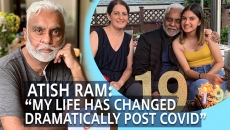Seeing him face many of his health challenges gave me a clearer understanding of how he succeeded in overcoming the many other trials of his life - both professional and personal.
Truth be told, I had begun to write about Dr. Narinder Singh Kapany, almost three years earlier. On December 12, 2020, I returned from his Bhog and Antim Ardas (gurudwara service) and started to reminiscence about the years between 2017 and now.
I now believe that what Dr. Kapany demonstrated in these three odd years was the epitome of his strong character. Seeing him face many of his health challenges gave me a clearer understanding of how he succeeded in overcoming the many other trials of his life - both professional and personal. This is why I felt it is important to include this insight in my original draft.
The Sikh Foundation 50th anniversary celebrations were planned for 2017. A year before in June 2016, his beloved wife of 62 years, Satinder Kaur, passed away. I sensed that this left a morass of grief, which he seemed to carry in his heart ever since. I believe that it was through his strong willpower that he kept himself going so that the Sikh Foundation anniversary could happen as planned. And it did in a splendid celebration at the Asian Art Museum and the Stanford University campus. It was a hugely successful event, attended by dignitaries from around the world and remembered fondly to this day. At this time, we also released my book Sikh Art from the Kapany Collection co-edited by Dr. Paul Michael Taylor, which documented his iconic art collection.
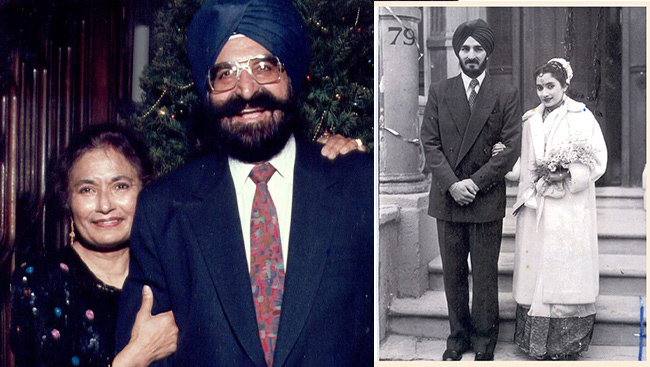
After all the guests had left, we felt we could now take a well-deserved break. Perhaps he too felt that the major goals he had set out for himself had been achieved. Shockingly, soon after the event he fell ill and was hospitalized. I remember clearly how I panicked in that moment, thinking that this would be the end. He now appeared with a certain human frailty in that moment, and so I began to draft my remembrance. But I underestimated the man I had closely worked with for the past 15 years.
After many ups and downs in his health, he strived on and repeatedly bounced back to his cheery self. How did he do it? Was it the force of his astute and agile mind? Was it his strict discipline and passion for his regimen? Or perhaps just his plain God-bestowed genius-ness, that enabled him to stay in Chardi Kala (a state of positivity), welcoming me with his cheerful, booming voice every time I met him, usually every Friday at his home in Woodside.
He adapted to a new lifestyle of working from home now instead of attending office daily from 10am-3pm at the Sikh Foundation in Palo Alto. Despite the daily challenges of managing his health, he continued to work for the Sikh Foundation giving interviews, meeting people and working on the numerous projects we have going. Using a wheelchair did not deter him from personally attending the opening of the Triton Museum of Art exhibit, which showcased works of nine contemporary Sikh artists including Arpana Caur and Devender Singh.
Adhering to his doctor’s orders he gave up his regular two glasses of red wine before dinner and switched to a shot of tequila. He never complained about his food, which had no salt. Instead, he added his own flair of a few drops of Tabasco hot sauce to keep it flavorful. He also attentively managed his personal assets and was even now, on the lookout for good business opportunities, reminding me that here was a man who had started a new solar energy company at age 84. I had seen him work on new ideas and patents well into his 80s.
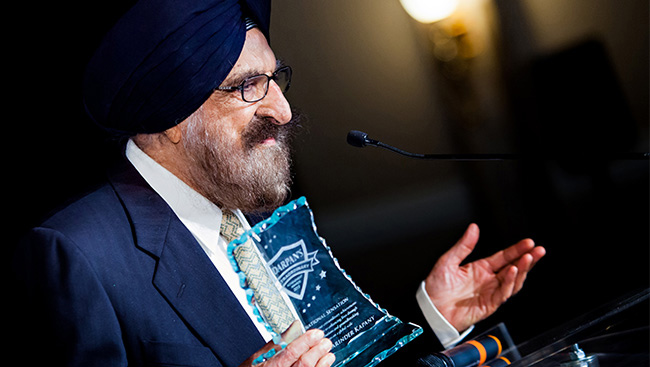
In my moments of doubt, he cleverly motivated me by turning the concept of entrepreneurship around and interpreting it as “Intrapreneurship” by which an employee can grow an organization by using similar principles.
He continued to aggressively negotiate and initiate new projects. He signed the deal with the Montreal Museum of Fine Art for the establishment of a permanent Sikh art gallery gifting them 150 artworks from the Kapany Collection. Just last month we were discussing a loan agreement for artworks to the Indian Heritage Center in Singapore for their upcoming exhibit “Sikhs in Singapore – A Story Untold”. He regularly listened to kirtan and paath (sikh devotional music and readings from the scriptures) on his small electronic Gurbani player. He continued to be steadfast in his faith. For him “Work was worship” and not the other way around, as most people settle for in the sunset years.
While he did establish enduring legacies at universities and museums, he was also mindful about the impact of smaller acts of charity, which he happily shared with those in need. He repeatedly joked that “eh sara kuch ethey hi reh jana hai” (all this wealth will be left behind). He personally helped me and my family find our footing in this new world, when we migrated here in 2005. Every minute of his 94 years of life were precious to him and he did not want to waste them. He even completed his memoirs during these three years and we were just getting ready to send it to the printers.
Many times over, he amazed me with his sharp insights and advice. He was always about the future and hardly ever dwelled on past glories. The prospect of the Nobel Prize would have excited men but not him when he was nominated for it last year. To me, he was larger than life then, and so he is now.
Amongst the most acclaimed scientists, researchers, academicians, entrepreneurs, philanthropists and art collectors in the world, his contributions span the fields of lasers, optics, medicine, academics, entrepreneurship, arts and philanthropy.
“Every morning in Africa a gazelle wakes up. It knows it must run faster than the fastest lion or it will be killed. Every morning a lion wakes up. It knows it must outrun the slowest gazelle or it will starve to death. It doesn’t matter if you are a lion or gazelle. When the sun comes up you’d better be running…”
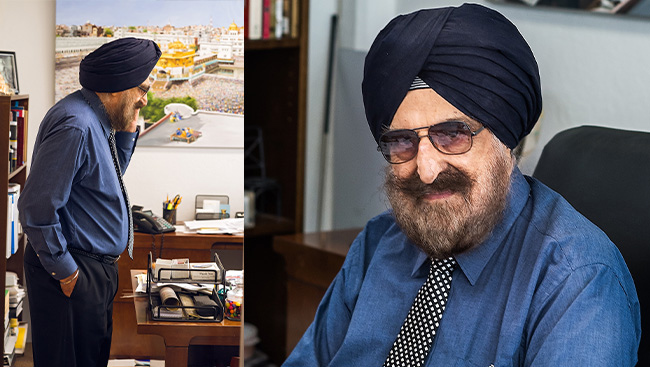
This framed quote on his office bookshelf sums up his hard working mindset and gives a good insight into the mind of Dr. Kapany, widely known as the “father of fiber optics”.
Born on October 31, 1926, in the town of Moga, Punjab-India, he grew up in the Himalayan foothill city of Dehradun and graduated in 1948 from Agra University. As early as 1947, he challenged the concept that light only travels in straight lines. He moved to London for his advanced studies in optics at the Imperial College of Science and Technology, where in 1952, he successfully demonstrated that light can be bent. This discovery changed the world forever. Coining the term Fiber-optics, he laid the foundations for the Internet age, which was to follow.
Soon after his marriage to Satinder Kaur, the couple migrated to the USA in 1955. He thrived as a research scientist first at Rochester University, NY, and then at the Illinois Institute of Technology at Chicago. His research in fiber optics, lasers, solar energy and its applications in defense, bio-medical instruments, communications and pollution control monitoring earned him more than a 100 important patents.
In 1961, his next big move was to San Francisco where he founded Optics Technology Inc. and successfully took it public in 1967. The San Francisco Examiner described him as “…the most dashing corporate officer in the area” (San Francisco Examiner February 9, 1961). He also founded Kaptron Inc. in 1973 and Solarpath in 2010.
He and his wife Satinder were both artists and also avid art collectors. They scoured the globe for all things Sikh, making their home in Woodside California a virtual museum. Dr. Kapany defined Sikh Art as – Art by, for and about Sikhs. Their expansive and magnificent Sikh Art collection is representative of Sikh artistic expression in all its forms – paintings, manuscripts, textiles, stamps, coins, arms and armor, and sculptures.
They not only put together a collection unparalleled in its range and quality but also were happy to share it with the world. Artworks were loaned out to numerous museums including the Victoria and Albert Museum in London, the Smithsonian in Washington DC, and the Rubin Museum of Art in New York for exhibits.
The seal ring of Maharaja Ranjit Singh, the delicate Sikh sketches by Emily Eden, the vibrant phulkaris embroidered by deft hands, the Nanak Shahi coins - symbols of Sikh sovereignty and so much more was shared readily with the world. I wonder how else would we, as a community, be able to experience the totality of our rich Sikh artistic heritage if it was not for this magnificent collection. This collection inspired others to build on this foundation.
In 2003, he gifted 100 magnificent Sikh artworks to the Asian Art Museum in San Francisco, establishing for perpetuity the Satinder Kaur Kapany Gallery of Sikh Art - the first permanent Sikh art gallery in the West. Recently, the Montreal Museum of Fine Art was the beneficiary of another significant gift of 150 artworks, leading the way for Canada’s first permanent Sikh art gallery.
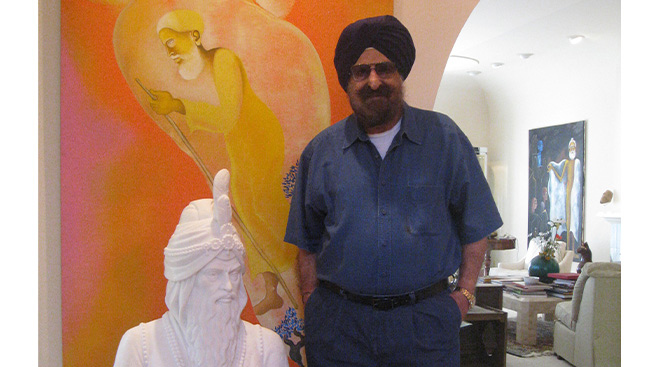
Throughout his life he took immense pride in his Sikh identity and heritage even headlining a newspaper article in 1957 as “Scientist wears turban and tie” (Chicago Daily News Wednesday. July 31, 1957) Philanthropy is not something he set out to do in his later years. He set up the Sikh Foundation as early as in 1967, with the promise to create an understanding of the history, art and culture of Sikhs. Speaking at the 50th Anniversary Gala of the Sikh Foundation at the Asian Art Museum in San Francisco, on May 5, 2017, he addressed the audience and said, “We should ensure that our friends of other faiths, races and cultures understand who and what we are. We must present the beauty of our heritage without chauvinism. The wisdom, philosophy and arts of the Sikh faith belong to the world.” He fully lived the Sikh concept of “Dasvandh” which is sharing one tenth of your earnings with others. His commitment to education inspired him to establish the first of its kind Kundan Kaur Kapany Chair of Sikh and Punjabi Language Studies in 1991 at UC Santa Barbara, which is named in honor of his mother. He also endowed a Chair of Opto-Electronics and a Professorship in Entrepreneurship at UC Santa Cruz. Honoring his father, Sundar Singh Kapany, he gifted his extensive collection of Sikh books to the McHenry Library at UC Santa Cruz along with the dedication of a reading room.
He led community efforts to establish three other Chairs of Sikh Studies at university campuses in California, generously contributing both time and resources. He also regularly contributed to support Sikh youth in the Punjab.
As an author and researcher, he published over 100 scientific papers and four books on Opto-Electronics and entrepreneurship. He was Regents Professor at the UC Berkeley and UC Santa Cruz and a visiting scholar to Stanford University in the Physics department and a Consulting Professor in the department of Electrical Engineering. In 1979 he started the Center for Innovation and Entrepreneurial Development (CIED) at UC Santa Cruz. He was an active member of the US National Inventors Council, Young Presidents Organization, The India-America Council, and Rotary Club ofPalo Alto.
Dr. Kapany received numerous awards including Excellence 2000 Award from the US Pan-Asian American Chamber of Commerce in 1998, the Pravasi Bharatiya Samman Award by the Indian Government in 2008, an Honorary Doctorate by the Guru Nanak Dev University, the Fiat Lux Award by University of California in 2008 and the Asia Game Changer West Award in 2019. His faith and pride in his Sikh heritage was deep-rooted and motivated his entire life.
He spent the last years of his life writing his memoirs The Man Who Bent Light which should be available in Spring 2021.
In his office at the Sikh Foundation in Palo Alto California hung a huge oil painting of the Kar Sewa at the Golden Temple by artist Sukhpreet Singh. In front of his desk stood a majestic bronze sculpture of Maharaja Ranjit Singh. I fondly recall him saying, “I am a lucky man. I have my Guru behind me and my Maharaja in front.”
Dr. Narinder Kapany passed peacefully in Woodside, California on December 3, 2020.
PHOTOS: Contibuted by Kapany Foundation, MP Singh Photography

